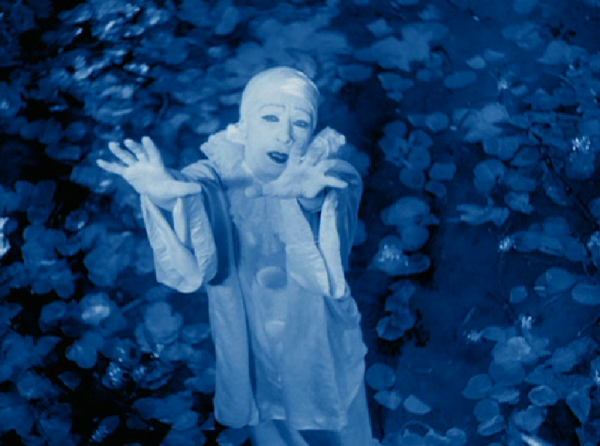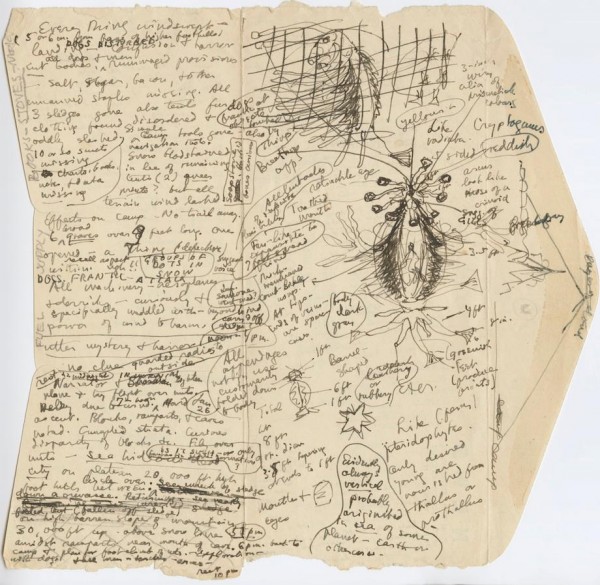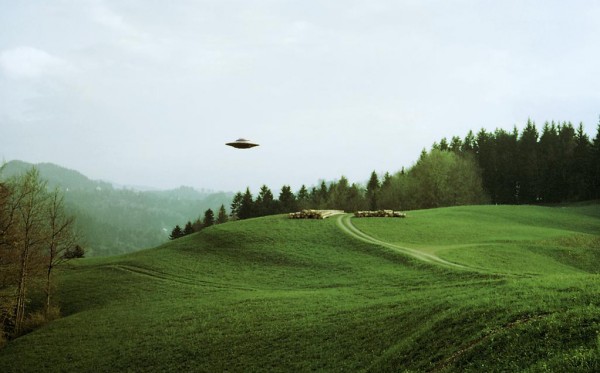Spinoffs
In orbital mechanics and aerospace engineering, a gravitational slingshot is the use of the relative movement (e.g. orbit around the sun) and gravity of a planet to alter the path and speed of a journey in space.
This article comprises several gravitational slingshots towards the unknown as a particular kind of human experience. The journey to know more about the unknown features approximations of: The unknown as an orientation aid, the significance of reality, imagination and representation. An attempt to try to find reasons for its attraction by drawing parallels to the aesthetics of the vague and the sublime. Furthermore it is trying to give a portray of various unknowns represented in science and fiction, featuring reports, assumptions and hoaxes in various media.
1. What does the unknown look like?

Every personal existence is oriented towards knowing more about why we are here. From the day of our birth we are confronted and attracted by the sheer reality of the unknown. The unknown is a particular kind of experience, it serves us as an orientation aid to get to know about the world that surrounds us. Without knowledge the world is blank and flat until we understand it [2].
Growing up you accumulate knowledge and you build up your imagination through media, through what you’ve learned, what you have been told. But as NASA scientists proved: representation of knowledge alters the way you deal with reality, you can even be blinded by knowledge: your creativity in thinking about possible uses of paperclips decreases from 98% for 5 year old children down to 12% for 15 year olds and adults remain with 2% creativity [3].
My claim is that the knowledge about the unknown paradoxically contracts and children see the unknown much more clearly as ossification hasn’t started [4]. Adults live more and more in the imagination and fall back onto generic stereotypes. To get an idea of what the unknown might look like we have to build up an image of something not based on anything you’re familiar with.
2. Is the unknown attractive?

Hasn’t the unknown a sting in the tail? Similar to a dog chasing its own tail but never able to reach it, we’re chasing the unknown to know more. Perceiving the unknown is a movement, a constant process in a world that is not simply available, it is constantly achieved rather than given: As soon as we know, the unknown has gone somewhere else. Continually getting itself out of reach it can never be obtained but returns eternally.
It shares its aesthetics with the vague. The Grimm brothers identify the vague with the vagabond, “sometimes encountered in the meaning of erratic, wandering but more common/frequently encountered as indeterminate” [6].
Trying to approached the unknown our imagination is overcharged, a momentum also found when confronted with the sublime. We perceive it as intangible and non-portrayable, it has no clear form or visible harmony and comes without borders. We encounter it with trepidation and can only grasp fragments [7]. Similar to the sublime its attraction can become uncanny, monstrous and can easily tip over from a beneficial encounter to a harmful scenario[8]. We’re attuned to it with admiration, adoration and respect and experience it as omnipresent and attractive.
3. Do we need the unknown?

In the exhibition Capital Affair the exhibition budget of 50000 Swiss franks was hidden somewhere in the venue. Visitors encountered an empty space and were invited to find the hidden money. By setting up an unknown location, Büchel
and Motti created a work where the existence of the money is still unknown. Thus activated, the exchange among the visitors generated a performance which became the raw material of the exhibition. The project not only poses questions of the value of the unknown in art, it uses the attraction of the money and the potential to find it to delegate creativity to the public.
This is one example that shows that interesting things happen when the known and unknown reside as coexisting forces. Things become attractive and dynamic when something unexpected and unknown is possible. If everbody had known where the money was hidden, the exhibition would not have been interesting anymore. If no one had known about it wouldn’t have had any effect at all.
4. Where can I find the unknown?

The unknown is omnipresent therefore it can be found on earth and in space. Just recently, the disappearance of the Malaysian aeroplane and its unknown whereabouts were filling the front pages of various newspapers. Due to the size of the plane and the availability of global tracking systems the loss is ungraspable. Our intrinsic tendency to find representations of possible destinations manifests itself in the diversity of speculations about the planes destiny, reaching from conspiracy/political intrigue over terror attack to therories similar to the Bermuda Triangle myth.
However in our culture the milieu for the unknown is outer space. The sky is not the limit, as Sun Ra worded in his ode from 1974 [10].
A place where you can be free
There’s no limit to the things you can do
Your thought is free and your life is worthwhile
Space is the place
Sun Ra’s words are portraying the sublimity of the sky, the infinity and endless possibilities hosted in space as freedom of thought. Nevertheless, we fall back on our imagination: what could be out there manifests in Extraterrestrial Intelligences and Unidentified Flying Objects.
5. Is space the place?

Representations of the unknown as ETIs and UFOs can be found in science and fiction. Since 2004, scientists have been controlling the Mars Rovers to search for evidence of extraterrestrial life-forms. The paper Would Contact with Extraterrestrials Benefit or Harm Humanity? is a scientific approach to represent the unknown in form of ETIs [8]. It gives an overview on the probability of an encounter, speculates about the advanced nature of extraterrestrials and is drawing
a possible ethical framework of ETIs. Possibilities of encounter might include a warm welcome of rolling out the red carpet (beneficial contact), or ETIs just get banged away like in The day the earth stood still [11] (harmful contact) or are
expected to have zero impact on us (neutral contact).

In fiction, encounters with ETIs have been imagined featuring assumptions and hoaxes. Examples are the Novel Somnium (1680) by German astronomer Johannes Kepler, which presents detailed analysis of the life forms that inhabit
Lavania [13] or the illustration of the “Zoo Hypothesis” in Kurt Vonneguts Slaughterhouse Five (1969) entailing the zoo-like exposure of the characters by ETIs on planet Tralfamadore[14].
Equally, encounters were made accessible to the public, through hoaxes like The Great Moon Hoax [15]. Journalists were using the name and reputation of the British astronomer John Herschel to feature a series of articles on the front page
of the 1835 New York Sun, stating that the amicable creatures of Vespertilio-homo, had been observed on the Moon. Not to forget about H.G. Wells 1897 novel War of the worlds describing the harmful scenario of a Marsian invasion towards Lon-
don [16], and its adaption into a radio-play by Orson Welles [17].
Whereas in Alive in Johannesburg (2006) a short film by Neill Blomkamp, ETIs representations were used to project and address problems faced on planet Earth. Original interview statements on the opinions of Zimbabwean refugees were combined with a documentary-style imagery to explore the themes of apartheid in a fictitious setting of an invasion by aliens that had to escape to earth as they were forced to live in conditions that were not good. [18]
As announced two weeks ago on the website of the Danish Film Institute the upcoming film The Visit (2014) by Michael Madsen can’t be left out in considering the slingshots towards the unknown. Currently in production, the filmmakers intention is to explore what an encounter with other intelligent life would mean to humanity’s self-image, trying to give answers on how we would receive them, speak to them and treat them [19].
6. How does the unknown come to earth?

How does the unknown finally come here? A good place to get an overview of the representations of the means of transport is Paul Meehans book Saucer Movies [20]. It is separating out works that deal with the wonder and terror of first contact with alien intelligence and is specifically examining the relationship between the cinema and the UFO phenomena. Starting chronologically from films like the Astronomers Dream from 1898 up to Contact in 1997 the book considers the significance of the debate concerning UFO contact, governmental conspiracies and UFO indoctrination. It comes with illustrations and a complete filmography.
Louis Theroux’s aim is “to discover the genuinely odd in the most ordinary setting”. In his Weird Weekends episode from 1998 on UFOs, he visits the deserts of the south west of the USA where UFO sightings are often reported. Focusing on several UFO hunters and contactees of ETIs, this episode features the attempt of several people to chase the unknown or establish contact [21].
The documentary Mirage Men (2013) portrays different people involved in UFO cases. It gives an insight into the medial construction of UFOs, how the US government used mythology to cover up their advanced technology and the psychological mechanisms behind it. It features the story of early contactees, their description of UFO sightings as well as people like Richard Doty, a professional dis-informant commissioned by the government [22].
7. Is there any conclusion?
Similar to the Unidentified Flying Object, which per se is unidentifiable although its definition can be found in almost every encyclopedia [23], the unknown is represented in our culture and manifested in various media representations. Touching examples in science, art and film show the importance and attraction of the unknown.
References
[1] C. Bonnet and J.D. Titius. Betrachtung über die Natur, 1774.
[2] Alva Noë. Varieties of Presence. Harvard University Press, 2012.
[3] G.T. Ainsworth-Land and B. Jarman. Break-Point and Beyond: Mastering the Future – Today. HarperBusiness, 1992.
[4] Bernhard, Thomas. Monologe auf mallorca, 1981.
[5] Anger, Kenneth. Rabbit’s moon, 1950.
[6] Karlheinz Barck. Ästhetische Grundbegriffe. Metzler, 2010.
[7] Stefan Majetschak. Ästhetik zur Einführung. Junius, 2007.
[8] Seth D. Baum, Jacob D. Haqq-Misra, and Shawn D. Domagal-Goldman. Would contact with extraterrestrials benefit or harm humanity? a scenario analysis. 68(11):2114–2129, 2011.
[9] Büchel, Christoph and Motti, Gianni. Capital affair, 2002.
[10] Sun Ra. This Planet Is Doomed: The Science Fiction Poetry of Sun Ra. Kicks Books, 2011.
[11] Wise, Robert. The day the earth stood still, 1951.
[12] Lovercraft, Howard Phillips. At the Mountains of Madness. Astounding Stories, 1936.
[13] A. Koestler. The Sleepwalkers: A History of Man’s Changing Vision of the Universe. Pelican books. Penguin, 1968.
[14] K. Vonnegut. Slaughterhouse-Five. A Dell Book. Random House Publishing Group, 1991.
[15] Herschel, John. The great moon hoax, 1835.
[16] H.G. Wells. The War of the Worlds. William Heinemann, 1898.
[17] Welles, Orson. The war of the worlds, 1938.
[18] Neill Blomkamp. Alive in joburg, 2006.
[19] Michael Madsen. The visit, 2014.
[20] P. Meehan. Saucer movies: an UFOlogical history of the cinema. Scarecrow Press, 1998.
[21] Louis Theroux. Louis theroux’s weird weekends: Season 1, episode 2 – UFOs, 1998.
[22] Lundberg, John and Denning, Roland. Mirage men, 2014.
[23] Olsen. Encyclopedia of definitions of the undefined, 2013.